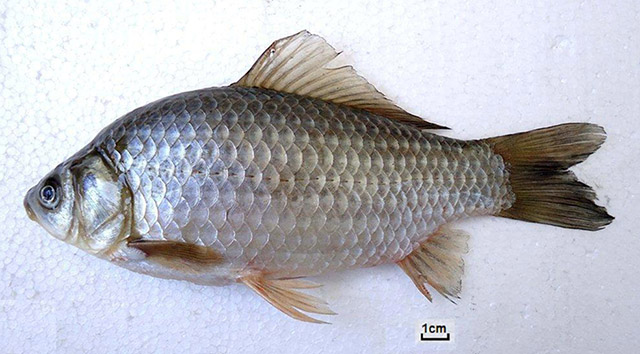| Cyprinidae (Minnows or carps), subfamily: Cyprininae |
| 46.6 cm TL (male/unsexed); max.weight: 3,000.0 g; max. reported age: 10 years |
|
benthopelagic; freshwater; brackish; pH range: 7.09999990463257 - 7.5; dH range: 12; depth range - 0 m, potamodromous |
| Europe and Asia: usually considered as native from central Europe to Siberia or introduced to European waters from eastern Asia. Clear and definite data on original distribution in Europe are not available due to introduction, confusion with Carassius auratus and complex modes of reproduction. At present, widely distributed and commonly stocked together with Cyprinus carpio which is transported throughout Europe. Absent in northern Baltic basin, Iceland, Ireland, Scotland and Mediterranean islands. |
|
Diagnosed from its congeners in Europe by having the following characters: body silvery-brown in color; last simple anal and dorsal rays strongly serrated; 37-52 gill rakers; lateral line with 29-33 scales; freed edge of dorsal concave or straight; anal fin with 5½ branched rays; and peritoneum black (Ref. 59043). |
| Inhabits a wide variety of still water bodies and lowland rivers, usually associated with submerged vegetation or regular flooding. Can strongly tolerate low oxygen concentrations and pollution (Ref. 59043). Lake dwelling individuals move into river mouths to avoid low oxygen water in winter (Ref. 39176). Feeding larvae and juveniles occur in high-complexity habitats as reed belts. Feeds on plankton, benthic invertebrates, plant material and detritus. Spawns in shallow, warm shores on submerged vegetation (Ref. 59043). Able to reproduce from unfertilized eggs (gynogenesis) (Ref. 41851). Life span reaches up to about 10 years (Ref. 59043). Eastern European or wild form of the goldfish (Ref. 1739). |
|
Not Evaluated (N.E.) Ref. (130435)
|
| potential pest |
Source and more info: www.fishbase.org. For personal, classroom, and other internal use only. Not for publication.
